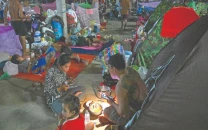Replace female genital mutilation with new rites of passage, says UN chief
The country with the highest rate of FGM remains Somalia where figures show 98 percent of girls have been cut

U.N. Secretary-General Ban Ki-moon in London, Britain February 4, 2016.
PHOTO: REUTERS
The call by the UN Secretary-General was heard by diplomats, campaigners and survivors gathered at the UN headquarters in New York to mark the International Day of Zero Tolerance for Female Genital Mutilation, which fell on Saturday.
Female circumcision on the rise in Malaysia
"I am especially inspired by communities that find better ways to mark the rite of passage into womanhood," said Ban.
He gave the example of young girls in Kenya and Tanzania spending a week away from their families to learn life skills instead of being cut.
The UN's children's agency UNICEF said on Friday more than 200 million girls and women globally have suffered genital mutilation, far higher than previously estimated.
Despite growing momentum to end female genital mutilation (FGM), experts warned that booming populations in some high prevalence countries were undermining efforts to tackle the practice widely condemned as a serious human rights abuse.
The UNICEF data covers 30 countries, but half of girls and women who have been cut live in just three countries - Egypt, Ethiopia and Indonesia.
The new global figure includes nearly 70 million more girls and women than UNICEF estimated in 2014, largely due to the inclusion of data from Indonesia which was left out in 2014 because there were no reliable national figures at the time.
The ancient ritual, practised across a swathe of African countries and pockets of Asia and the Middle East, usually involves the partial or total removal of a girl's external genitalia.
Speaking on the panel, Kenyan FGM survivor Keziah Bianca Oseko, called the practice "barbaric" and said the trauma of being cut pushed her into activism against FGM. "I now have to stand up and fight for the rights of women," she said.
Tanzanian girls return after escaping genital mutilation
Malian survivor Inna Modja, a professional singer who now lives in France, spoke of experiencing a loss of identity as a teenager having been subjected to the ritual at age four.
"I felt that I would never become a women because I had something missing," she said, tears welling up in her eyes. "Cutting me was telling me that I'm not good enough."
Ending female genital mutilation is part of a set of development goals adopted by UN member states last year. Goal five counts among its targets eliminating FGM by 2030.
But high fertility rates in countries where FGM is prevalent poses a sizeable hurdle, the UN population fund's (UNFPA) executive director, Babatunde Osotimehin, told the audience.
"If current trends continue, the number of girls affected by FGM in high-prevalence countries is likely to increase," Osotimehin said.
The country with the highest rate of FGM remains Somalia where figures show 98 percent of girls and women aged between 15 and 49 have been cut. Guinea, Djibouti and Sierra Leone also have very high rates.



















COMMENTS
Comments are moderated and generally will be posted if they are on-topic and not abusive.
For more information, please see our Comments FAQ